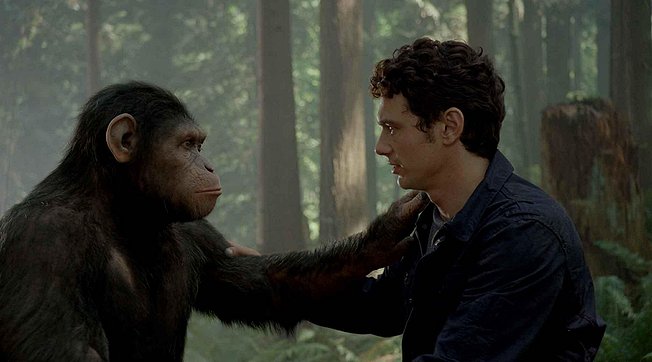Rise of the Planet of the Apes
Directed by: Rupert Wyatt
Starring: James Franco, Andy Serkis, John Lithgow, Freida Pinto, Brian Cox, Tom Felton
Rated: PG-13 for violence, terror, some sexuality and brief strong language.
Prequels are by definition at something of an advantage — knowing even the basic plot of the stories that take place after them means that you have at least general knowledge of how the prequel must end. “Rise of the Planet of the Apes” definitely has this problem; even folks who haven’t seen the other “Planet of the Apes” movies know how things wind up. Even so, the characters (both human and ape) are engaging enough to draw viewers into the film.
The story is a complex and detailed one, but its heart is the relationship between Will (James Franco), a scientist working on gene therapies to heal the brain, and Caesar (Andy Serkis), a chimp with greatly enhanced intelligence born to one of his experiment subjects. Will raises the chimp almost like a son, teaching him to read and understand human speech, and to communicate in sign language. While Will and his father Charles (John Lithgow) love Caesar, the young chimp’s experiences with other humans, particularly the sadistic assistant at a local primate shelter played by Tom Felton (who, after eight films as Draco Malfoy appears to have given in to typecasting), are far less pleasant.
Computer generated special effects have come a very long way in recent years, and the motion-capture which gave us Gollum in “The Lord of the Rings” films now gives us apes with amazingly nuanced performances that would be essentially impossible to create with the actual animals. It is, for the most part, easy to forget that we’re watching something created by a computer, and simply be drawn into the story.
There are numerous advantages to using motion-capture to create completely-CGI characters, and they all make “Rise of the Planet of the Apes possible. The actors playing the human characters deliver better performances when they can interact with actors playing the CGI characters, and the movement and weight of the CGI characters is vastly more convincing when they’re being designed on top of actual people rather than created out of whole cloth. A further advantage in this particular film is that the “uncanny valley” problem, where too-realistic CGI humans look far creepier than less-realistic ones, isn’t present because apes are sufficiently different from people.
The story is well-written; not only is the plot well-crafted, but the characters are well-developed enough that the actions they take that turn the plot in its inevitable direction are believable. This isn’t a particularly intelligent film, but it’s wise enough to make the occasionally stupid things its characters do believable by laying down clear motivations early on.
After the last “Planet of the Apes” film, viewers are right to be more skeptical than enthusiastic for this one. However, “Rise of the Planet of the Apes” shows every sign of being a new dawn for the franchise. No, this isn’t a particularly thoughtful or intelligent film (it often makes its points with a metaphorical two-by-four to the skull), but it’s not a big, dumb summer movie, either. This is a well-crafted story peopled by engaging characters, and one which uses special effects carefully and, for the most part, very well. This is a movie likely to satisfy all but the art-house crowd.
